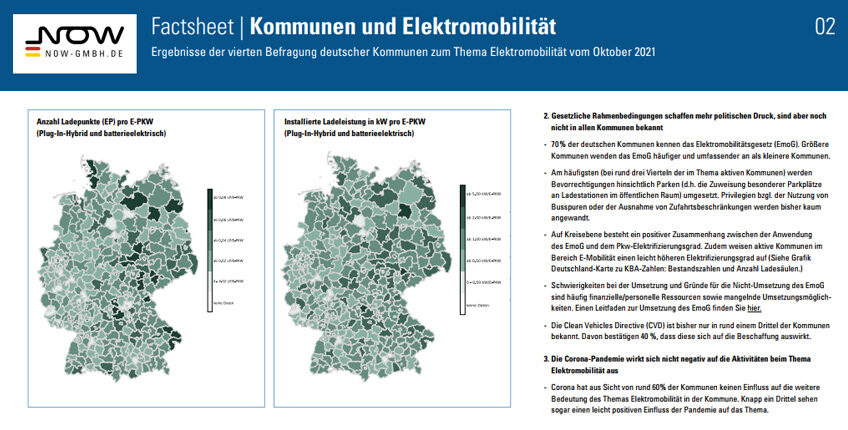The results of the 4th survey of German municipalities in the field of electric mobility were presented today at the 8th “Elektromobilität vor Ort” specialist conference on local electric mobility, of the Federal Ministry for Digital and Transport (BMDV – Bundesministerium für Digital and Transport).
The survey paints a picture of highly committed municipalities that are driving e-mobility forward in Germany in a very significant manner. Nevertheless, human and financial resources as well as advisory services are still often lacking. To support this, the BMDV published a further call for funding for electric mobility concepts.
The survey was conducted in autumn 2021 and investigates the activities of municipalities in the field of electric mobility. 631 German municipalities with a population of 5,000 or more were surveyed by the Fraunhofer Institute for Systems and Innovation Research (ISI) on behalf of the BMDV. The survey continues the series of previous city surveys conducted by the BMDV in 2011, 2014 and 2017/2018. The aim is to investigate which fields of action are at the forefront of municipalities’ minds and what needs exist for the further development and expansion of electric mobility.
80 percent of German municipalities are already active in the field of electric mobility
The vast majority of municipalities, around 80 percent, have already taken measures to promote electric mobility locally, and just under 10 percent are planning to do so. Large cities are more active than smaller municipalities. The measures of the active municipalities mostly include the construction of a local charging infrastructure or the procurement of electric vehicles for the municipal fleet. Besides the potential of electric mobility regarding climate protection, the reasons for the high level of commitment are also cited as being the positive impact on the image of the municipality. When municipalities do not get involved, lack of personnel and financial resources are most frequently cited as reasons.
Legal framework conditions exert pressure
70 percent of German municipalities are aware of the Electric Mobility Act (EmoG – Elektromobilitätsgesetz). In most cases, the EmoG is used to create privileges for electric vehicles when parking. Other privileges, such as the use of bus lanes or the exemption from access restrictions, are hardly used. Those municipalities applying the EmoG also have a higher degree of electrification. However, the Clean Vehicles Directive (CVD) and thus the Clean Road Vehicles Procurement Act (“Gesetz über die Beschaffung sauberer Straßenfahrzeuge”) is so far known to only about one third of the surveyed municipalities. For the first time, the law sets binding minimum targets for the public procurement of low and zero-emission passenger cars as well as light and heavy-duty commercial vehicles, especially for buses in public transport.
Municipalities need more information and advice
The majority of municipalities would like to advocate for more electric mobility at the local level. However, there are often obstacles in the implementation and there is a great need for advice, such as on funding applications or the expansion and standardisation of charging infrastructure. To achieve this, human resources must be built up and the necessary information must be made available.
A first starting point is the Electric Mobility Jump-Starter Set (“Durchstarterset Elektromobilität”), which is available from NOW digitally. The package contains practical tips and recommendations for action on how municipalities can enter and expand electric mobility at the local level.
More information:
- www.starterset-elektromobilität.de
- Clean Vehicle Directive
- Factsheet on the results of the 4th survey of German municipalities on electric mobility (Factsheet zu den Ergebnissen der 4. Befragung deutscher Kommunen zum Thema Elektromobilität)
- Practical implementation guide on the Electric Mobility Act (EmoG) (Praxisorientierter Umsetzungsleitfaden zum Elektromobilitätsgesetz (EmoG))
- 2021 Report on the Electric Mobility Act


